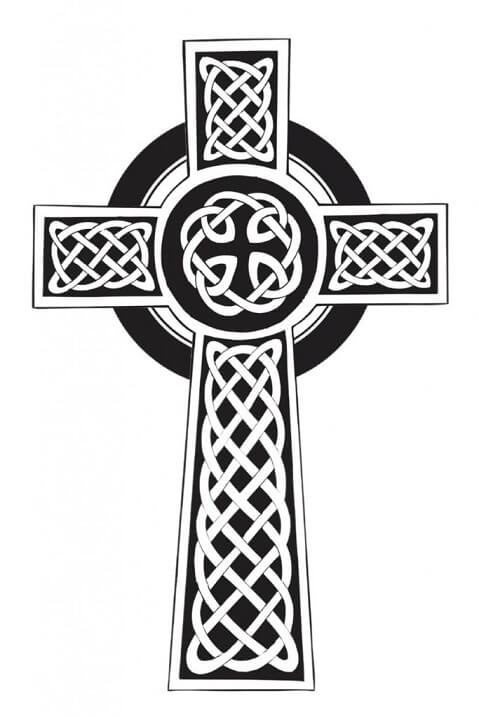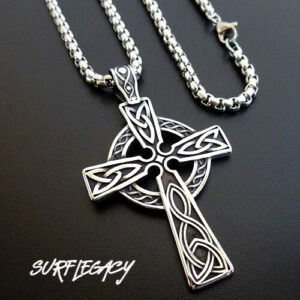The Celtic Cross, also called Irish Cross, Scottish Cross, High Cross, or Celtic wheel is an ancient Celtic symbol.
The appearance of the cross in the circle as a symbol has ancient origins that can be placed in the magical-religious tradition of the Celts, a pre-Christian people from Ireland who also migrated to other parts of Europe.
It is a symbol used today in many contexts, both religious and not. The Celtic cross is like a traditional cross but with a ring around the intersection of the stem and arms. The entire cross is often decorated with Gaelic motifs. It is a symbol that comes from the past but is also used today.
Today, as centuries ago, large crosses surrounded by stones are scattered throughout the countryside, towns, and monasteries of Ireland.
They are found, to a lesser extent and in different forms, in the remaining parts of Celtic Europe such as Scotland, Wales, Cornwall, and Brittany.
Carved mostly from sandstone, they are found almost everywhere: often to indicate the boundaries of monasteries, a tomb, dedicated to a king or saint, placed in places of prayer or to protect against the forces of hell.
Celtic Crosses were perfected and developed starting from the 6th-7th century AD. until the 12th century, disappearing after the English conquest of 1170.
The culminating period of this form of sculpture was that of the troubled centuries agitated by the Viking and Scandinavian invasions when the raids of these barbarian populations attacked the great Irish monastic centers. Origins of the Celtic Cross
There are several variants of Celtic Crosses, some of which have very complex engravings and processes. It may happen that human figures are represented there, to narrate biblical events.
In general, however, the knots, the spirals, the geometric interweaving and the zoomorphic motifs are the ones that appear most often; these are the same elements that characterize the metal objects and the illuminated manuscripts of the same period.
Unlike the crucifixion scenes in Southern Europe that show the suffering of Christ, generally half naked and battered by the wounds inflicted on him, the Celtic Cross seems made to be aesthetically beautiful.
When human figures appear, they are very simple when compared to the intricate and complex decorative motifs that surround them.
Origins of the Celtic Cross
It is thought that the first Celtic Cross, is that one found in a cave to Lascaux, near the French Pyrenees, going up again around the 10.000/15.000 a.C.
In the so-called Room of the Felines of the Lascaux caves, there is an ancient graffito with a simple symbol in the shape of X with three vertical rods, similar to the number 13 of the Roman numeration.
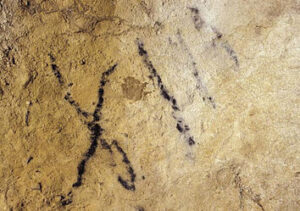
Considered the first Celtic Cross found in Lascaux caves
In the Middle Ages it was used in the Christian context, particularly by Celtic Christianity. The Celtic cross derives from the superimposition of an empty circle and a Greek or Latin cross, so that the center of the circle coincides with the point of intersection of the arms of the cross.
In the Celtic regions of Ireland and Great Britain there are many isolated Celtic crosses, erected mostly from the 7th century onwards. Some of these bear inscriptions in the Celtic Oghamic alphabet, some in Runic, an alphabet used by Germanic peoples.
Such crosses are found in Cornwall, Wales, on the Isle of Iona and in the Hebrides, but most are found in Ireland. Other stone crosses have been found in Cumbria and southeast Scotland, not all of which are of Celtic manufacture, some are of Anglo-Saxon manufacture.
The most famous Celtic crosses are the Cross of Kells in County Meath, the crosses in Monasterboice in County Louth and the Cross of the Scriptures, Clonmacnoise, in Ireland.
High crosses in Ireland can be viewed at:
- Kells, Meath
- Dysert O’Dea Monastery, Clare
- Glendalough, Wicklow
- Ahenny, Tipperary
- Clonmacnoise, Offaly
- Monasterboice, Louth
The last, in particular, about four meters high and carved from a single block of sandstone, is undoubtedly one of the most beautiful Celtic crosses that have come down to us.
Located inside the monastery of Clonmacnoise, it was divided into panels showing scenes from the Bible, such as the Last Judgment and the Crucifixion of Christ.
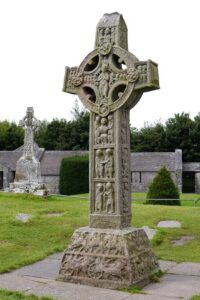
Celtic Cross Clonmacnoise
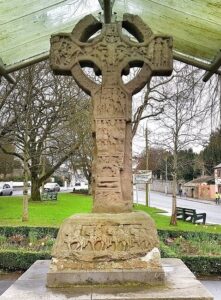
Kells-market-high-cross
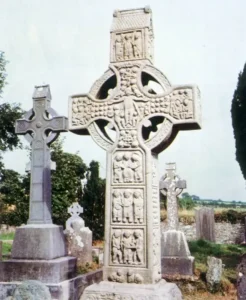
Muiredach’s High Cross
Even before Christianity, crosses with a circle have often been found. They are called “solar crosses,” and have been found in Northwest Europe (the symbol was associated with the Norse god Odin) and also in the Pyrenees and the Iberian Peninsula.
However, there is no evidence of a connection or common origin with the Christian cross.
Saint Patrick and the Celtic Cross
Legend has it that when St. Patrick, coming from Rome, returned to Ireland to evangelize the country, his mission was largely successful thanks to his sensitivity in never trying to suppress the pagan beliefs of the Celts and trying in every way to combine the new Christian faith with the existing symbolism.
So it was that after the shamrock, which the saint used to explain the trinity, he changed the icon of the Christian cross to the Celtic cross.
In this regard, it is said that St. Patrick, praying in front of a sacred stone bounded by a circle, had the idea to draw a Christian cross within the sacred circle, blessed the stone and thus gave “beginning” to the first Celtic cross in the Christian context.
In fact, St. Patrick, who knew the Irish language and culture thanks to the period of slavery lived on Slemish Mountain, added the sun, a powerful Celtic symbol, to the Christian cross, to facilitate the assimilation of this icon.
In fact, he realized that in order to involve the local people in his preaching, he would have to draw on images that were known and could be trusted.
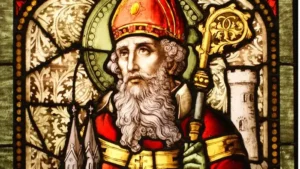
Image: Wikimedia Commons
But going beyond the legends, the Celtic cross actually has a plurality of meanings that have been layered throughout history
Celtic Cross meaning
The Celtic Cross has always fascinated for its powerful symbolic value that has taken on different connotations according to historical periods and cultural changes. For the Celts, it represented the link between the life-death axis, of the world (the cross), understood as metamorphosis, and the mind of man, conscious reason (the circle).
The Celts, like all ancient peoples, assigned their very high symbols magical-ritual mystical meanings linked to the world of Nature and the Sacred. Nature, the Great Mother, was the first evolutionary step in the life of man and the every day, full of absolute moral values, was kept in constant contact with divinity.
The circle, the solar symbol of the conscious ego (reason), combined with the cross of metamorphosis (death as the womb and origin of new life) thus gave representation and expression of faith in spiritual evolution.
The cross also represented the arms of man (horizontal bar) and the body (vertical bar) and its more general value was the conjunction of the opposites, the negative (horizontal) with the positive (vertical), the inferior with the supernal, death with life.
Astrological Meaning
The meaning more commonly assigned to this symbol is that solar, united to a meaning of through and connection between the earthly world and celestial world, due to the fact that often the horizontal axis is brought back to the representation of the earthly dimension while that vertical one to the celestial dimension.
The earth is represented from the horizontal axis while the celestial world from the vertical one. Instead, the point of intersection of the two axes represents the Pole, the center of things and the world, the point around which everything rotates, which directs the movement of life without participating in it.
Theological Meaning
In this meaning, the cross represents the meeting place of divine and human energies: the ego, nature, wisdom and divinity.
In the center of the cross-section, there is the energetic point where the cosmic power is concentrated and resides: according to this interpretation each arm of the cross embodies a branch of wisdom and the circle unites the four elements thus representing an ideal spiritual and meditative path.
Temporal Meaning
When the cross did not belong to Christian iconography, it had a meaning deeply connected to the changing of nature and the seasons.
In the Celtic world, in fact, it represented the changing of the seasons and the four fundamental Celtic moments that mark the changing of time.
The four arms of the Celtic cross symbolize:
- Samhain: New Year, around October 31
- Imbolc: Feast of the return of Light – around February 2
- Beltane: Feast of Summer – around the 1st of May
- Lughnasadh: Harvest Festival – around August 1
The other four junctions given by the circle are the minor moments:
- Yule: the winter solstice – around December 21-22
- Ostara: the spring equinox around March 22-23
- Litha: the summer solstice celebrated at 21-22 June
- Mabon: the autumnal equinox, around 22-23 September
The Celtic cross, therefore, becomes a tool to remember the passage of time and the caducity of life. In this temporal perspective, the Celtic cross can also be read as the alternation of day and night, if we consider the horizontal bar of the cross as the horizon, the upper half would represent sunrise, and sunset.
This would be very relevant when we see the circle around the cross (in the same way as in the ancient Irish cross still used today) we would get the sense of the earth similar to a sphere, with the sun rising around it (in the upper part of the semicircle while the lower part would indicate the night when the sun is not visible to the eyes).
Since the most ancient times, it has always been a symbol rich in very complex meanings: the four cardinal points (north, south, west, east), the four elements of the Universe (Water, Air, Earth, Fire), the four seasons, the four festivities of the Celtic calendar (Samhain on November 1st, Imbolc on February 1st, Beltane on May 1st, and Lughnasadh on August 1st).
The Celtic cross could also signify day and night, if you consider the horizontal bar of the cross itself to be the horizon, and the upper half to be the sunrise and sunset.
Many meanings have been attributed to the Celtic cross, the most important ones can be summarized as follows
- Hope
- Life
- Honor
- Faith
- Unity
- Balance
- Transition
- Temperance
- Ascension
- Navigation
Celtic cross tattoo
Since the Celtic Cross is a symbol full of symbolic meanings, it is no wonder that it is a very popular tattoo nowadays and more and more people decide to get a Celtic cross tattoo.
The Celtic cross is not only tattooed by Irish people who are proud of their origins, but also by ordinary people who are looking for their spiritual and cultural identity through this symbol.
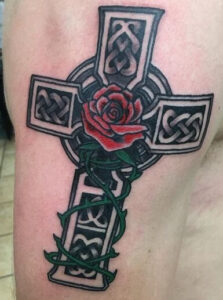
Celtic Cross Today
Fallen into oblivion for centuries, it returned to prominence in 1853, when it was the protagonist at the industrial exhibition in Dublin as evidence of the rebirth of Irish identity, which influenced various sectors of culture and art. So much so that the architects of the time revived it in the cemeteries in Victorian Dublin.
The symbol became so popular that it inspired Scottish jewelers Alexander and Euphemia Ritchie who, from 1899 to 1940, used it for their creations.
The Celtic cross is still widely used in jewelry today. In the form of a pendant or a handcrafted object in wood or glass, it is one of the most popular souvenirs from international tourism.
The Northern Ireland national football team and the Athletic Gaelic Association, which brings together typical sports, hurling and Gaelic football, also sport this now legendary cross as their logo.
Buy a Celtic Cross Pendant
Are passionate about Celtic Culture? Finding the ideal piece of Celtic Jewelry can be challenging, especially if you lack inspiration or don’t know where to look. At Surflegacy, we have a wide range of Norse Jewelry in various styles, shapes, colors, and materials, to accentuate your Viking spirit and look. Visit our shop here

